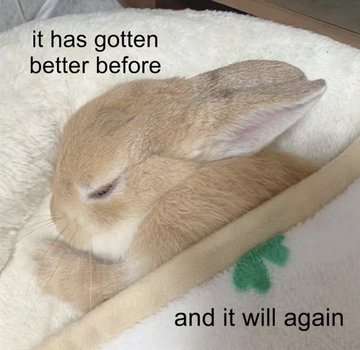

Tell them to look up ‘settler-colonialism’ and ‘lebensraum’.


Tell them to look up ‘settler-colonialism’ and ‘lebensraum’.


If I recall correctly what R studio is, it’s just an IDE for the R language. There are, at the very least, alternatives to it, including VS code.
On that note, I have been meaning to relearn R. I should set up VS Code to work with it, and/or try R studio.


It seems that potatoes’ price is significantly higher in 2024 than in 2023, so that doesn’t explain things.


You have to also consider that the salaries are much lower in Russia.


‘R’ as in, the language?


Kamala promised a rep in her cabinet, so Trump is responding with a dem in his.


I hope this comment will be my sole involvement in all of this, but this doesn’t explain why specifically choose the word ‘gossip’ - which you yourself point out has a history of being used to humiliate women - and not any less controversial option, aside from ‘the moderators are dedicated to reclaiming the word’. You also seem to be conflating engagement in the activity and using the word as a name for the activity.
I don’t think that this is a good time for the mod team to stand their ground on this issue, as opposed to, for example, holding a vote on whether or not people are okay with the name.


Notably, the Tau were introduced only a few years after the setting turned grimdark.


Tell cats to stop fighting at night.


Imagine being aware of LIFO OVS notation, but not being aware of PEMDAS /s


If memory serves, I was looking for front-ends for  . Accidentally found Hexbear and made this account a couple of months later.
. Accidentally found Hexbear and made this account a couple of months later.
Don’t really see a reason to leave, especially considering that I have almost no social life outside of here.


Surprise is the best element for every weapon.


It has now become 20% cooler.


I’m going to note that you are very reluctant to actually elaborate on many of your points, including which socialist projects have a better record of being on the right side of history. Seriously, how many can you name other than Cuba and East Germany?


Also, surely you don’t hold the pogrom-loving Makhno’s territories in higher regard, do you?


Okay, why do you hold, for example, Vietnam in higher regard than the USSR? Why do you consider Angola to be better than the USSR? Why the early PRC over the USSR?


Which socialist projects do you hold in higher regard?


You’re completely missing the point of what I said for the sake of defensiveness
Firstly, what points am I missing?
Secondly, you mistake an honest attempt to educate as ‘defensiveness’. If you want to try to escalate, I assure you that I can bite back and that I have studied the topic. I would like to ask you to keep things civil, however.
Your points are all broadly addressed in whar youre replying to
Except, they are evidently not.
You do not address the fact that the Bolsheviks were progressive even by today’s standards (the guaranteed housing alone is a very significant development that is possible due to planned economy and you may notice that planned economies at least usually - if not always - provide guaranteed housing).
You do not address the fact that the USSR did quite a bit more than ‘the bare minimum’ internationally, either. The claim in your original comment is outright false.
You do not address the fact that your claim that ‘they relished the misery, fetishized the sacrifices, and frequently missed the god damn point’ is just fantasy that doesn’t mean anything and is just meant to very vaguely paint communists in a bad light.
I am going to note that you refused to elaborate on any of that.
I do have one issue with VSCodium, which has turned me off from it - it lacks some of the extensions. I also recall that I ran into trouble with it when configuring it for, I believe, C++ or PHP, but that might just have been a ‘me’ issue that will get resolved after I get more comfortable with TypeScript.